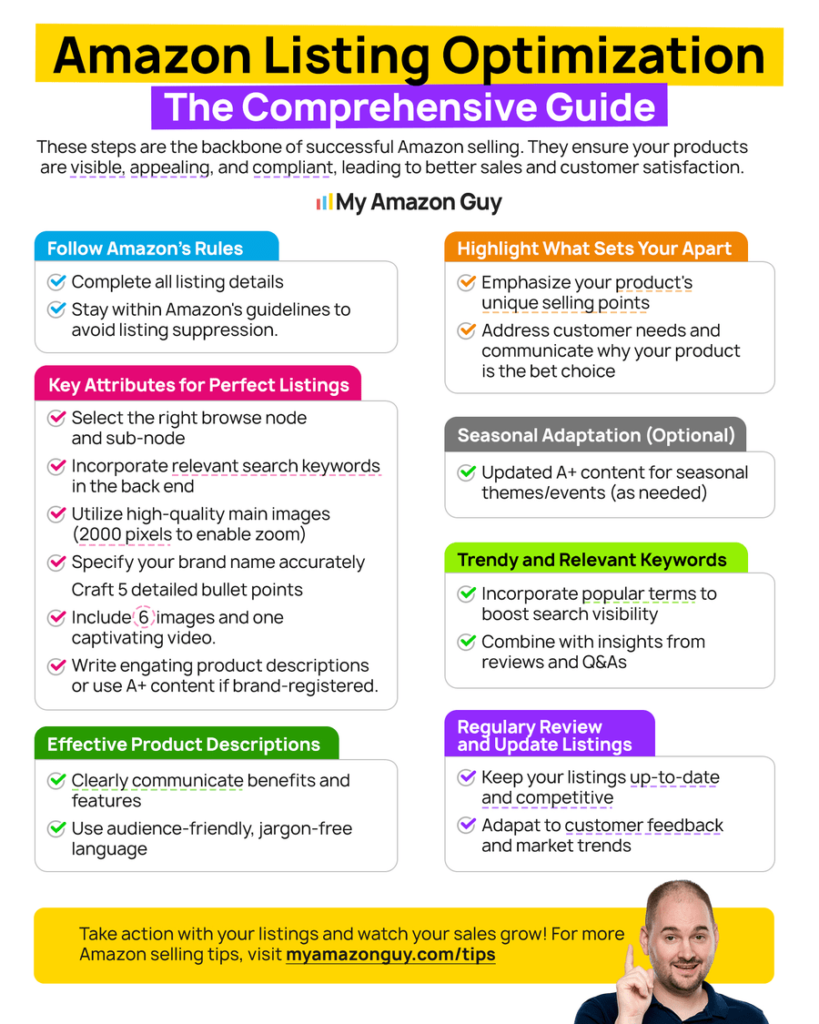Personalization is key to thriving on Amazon. To stand out, sellers must craft tailored experiences that resonate with individual customers.
Effective personalization involves more than just product recommendations; it enhances customer satisfaction and loyalty through customized offers, promotions, and communications. When customers feel truly understood and valued, they are more inclined to make repeat purchases, become brand advocates, and increase their spending.
This guide looks into the specific challenges faced by both FBA and FBM sellers in delivering personalized experiences. It offers practical solutions to these challenges, empowering sellers to boost customer satisfaction, drive sales, and cultivate enduring relationships.
By mastering these strategies, you can elevate your Amazon business and create a remarkable shopping experience for every customer.
Overcoming Personalization Challenges for FBA Sellers
FBA sellers face specific hurdles in creating personalized shopping experiences. Limited control over customer interactions, reliance on Amazon’s systems, budget constraints, data access, and scaling issues impact their ability to deliver tailored offers.
Below are the challenges FBA sellers encounter and our Amazon agency provided practical solutions to overcome them.
1. Limited Control
FBA sellers have minimal direct contact with customers, unlike FBM sellers who handle customer inquiries directly. This hinders data collection, relationship building, and real-time personalization.
Relying on Amazon’s customer service can lead to inconsistent experiences and fewer opportunities to provide personalized interactions.
Solutions:
- Product Optimization: Improve product descriptions, listing images, and A+ content to create a compelling product experience. This indirectly builds customer relationships through product information.
- Amazon’s Analytics: Use Amazon’s built-in analytics tools to gather data and identify trends. This provides insights into customer behavior without direct interaction.
- Strong Brand Presence: Develop a strong brand identity outside of Amazon to enhance direct customer engagement and foster a personalized connection beyond the platform.
- Amazon Brand Registry: If eligible, make use of Amazon’s Brand Registry to access additional customer data and control brand messaging. This empowers sellers with more data-driven decision making.
- Post-Purchase Engagement: Focus on the post-purchase experience through personalized thank-you messages, relevant product recommendations, and encouraging customer reviews. This builds relationships despite limited purchase interactions.

2. Dependency on Amazon's Systems
FBA sellers are heavily reliant on Amazon’s platform for order fulfillment, customer service, and data access. This dependency restricts the integration of custom personalization tools and limits access to consumer data.
Additionally, Amazon’s system constraints and platform changes can hinder the implementation of advanced strategies that can help in creating personalized experiences for buyers.
Solutions:
- API Utilization: Amazon provides a robust API that allows sellers to access data and perform various actions programmatically. This can be used to gather additional data, integrate with other systems, and automate tasks.
- Third-Party Integrations: There are numerous third-party tools and services designed to work with Amazon’s platform. These can provide additional functionalities, data insights, and automation capabilities.
- Continuous Monitoring and Adaptation: Stay updated on Amazon’s platform changes and adjust strategies accordingly.
3. Budget Constraints
FBA fees, including storage, fulfillment, and referral fees, can significantly impact a seller’s budget. This limits the allocation of resources for personalization initiatives, hindering investments in advanced tools, data analysis, and personnel.
The need to justify the return on investment (ROI) for personalization initiatives becomes more critical due to the higher operational costs associated with FBA.
Solutions:
- High-Impact Tactics: Focus on strategies with the highest potential ROI to optimize resource allocation.
- Free or Low-Cost Tools: Utilize free or low-cost tools for data analysis, email marketing, and social media management.
- Experiment and Iterate: Test different personalized strategies to identify the most effective approaches and optimize spending.
4. Data-Driven Decisions
FBA sellers often face challenges in accessing and analyzing comprehensive customer data due to limitations imposed by Amazon’s platform. While some data is available through Amazon’s analytics tools, it might not provide the necessary depth and granularity for effective personalization.

Solutions:
- Amazon’s Analytics: Utilize Amazon’s built-in analytics tools to gather available consumer data and identify trends.
- Combine with External Data: Supplement Amazon data with information from other sources (e.g., social media, website traffic) to create a more complete customer profile.
- Product-Level Data: Analyze product-level data (sales, reviews, returns) to understand customer preferences and optimize offerings.
- Customer Segmentation: Create customer segments based on available data to tailor marketing campaigns and product recommendations.
5. Scaling Success
As FBA businesses grow, scaling personalization efforts becomes increasingly complex due to limitations imposed by Amazon’s platform. Handling increased order volumes and customer numbers while maintaining personalized experiences requires efficient strategies.
Solutions:
- High-Value Customer Segments: Focus on customer segments with the highest potential return on investment to optimize resource allocation.
- Amazon’s Automation Tools: Utilize Amazon’s built-in automation features, such as Amazon Personalize, to streamline personalization processes and improve efficiency.
- A/B Testing: Continuously experiment with different strategies to identify and generate personalized customer experience approaches that are the most effective.
Overcoming Personalization Challenges for FBM Sellers
While FBA sellers face unique hurdles, FBM sellers also encounter their own set of problems when trying to personalize the shopping experience of their customers. Managing day-to-day operations, dealing directly with customers, and investing in technology are just a few of the challenges that FBM sellers must overcome.
Below are these issues and we’ve offered solutions to solve them.
1. Logistics and Fulfillment
FBM sellers face significant challenges in managing inventory, shipping, and returns, which can divert resources from personalization efforts. Inefficient logistics can negatively impact customer satisfaction and hinder data collection for personalized experiences.
Solutions:
- Inventory Management: Implement effective inventory management systems to ensure product availability while minimizing excess stock.
- Efficient Shipping Processes: Streamline shipping operations to reduce delivery times and costs, boosting customer satisfaction.
- Customer-Centric Returns: Create a hassle-free returns process to enhance customer experience and gather valuable feedback.
- Data Collection During Fulfillment: Capture relevant customer and order data during the fulfillment process so that you’ll be able to personalize user experience in the future.
2. Customer-Centric Approach
Direct customer interaction, while providing valuable insights, can be time-consuming for FBM sellers. Handling inquiries, returns, and complaints can divert resources from strategic personalization initiatives.
Maintaining consistency in customer interactions and capturing valuable data during these exchanges presents additional challenges.
Solutions:
- Efficient Customer Support: Implement efficient customer support systems to handle inquiries promptly and seamlessly.
- Data Capture During Interactions: Develop processes to capture relevant customer data during interactions that can help in generating a highly personalized experience for individual users.
- Customer Service Training: Provide customer service teams with training on personalization strategies to ensure consistency.
- Customer Feedback Analysis and Action: Analyze customer feedback to identify trends and opportunities for improvement, then implement necessary changes. Utilize tools like Feedback Whiz to streamline this process.
Did you know that you can avail of a service that lets Amazon handle customer service on your behalf even if you are an FBM seller? Find out how by watching this video:
Key Points:
- New Amazon Service: Amazon introduces a new program for Amazon sellers.
- Customer Service Handling: The program handles customer inquiries for self-fulfilled orders.
- Program Cost: There’s a fee associated with using the service.
- Potential Benefits: The program offers potential benefits like improved customer service and fewer A-to-Z claims.
3. Technology Investments
FBM sellers often need to invest in their own technology infrastructure, including customer relationship management (CRM), marketing automation, and analytics tools. The initial costs and ongoing maintenance can be substantial, and integrating these systems can be complex.
Solutions:
- Evaluate Technology Needs: Assess specific business requirements to identify essential technology investments.
- Prioritize Investments: Focus on tools that directly impact customer experience and personalization efforts.
- Cloud-Based Solutions: Consider cloud-based solutions to reduce upfront costs and improve scalability.
- Data Integration: Invest in data integration tools to connect different systems and create a unified view of consumer data.
- Technology Partnerships: Explore partnerships with technology providers to share costs and expertise.
4. Data Privacy and Compliance
FBM sellers face complex data privacy challenges. Direct customer interaction, handling sensitive data, multiple platforms, and evolving regulations increase compliance risks.
Mishandling data leads to penalties, reputational damage, and trust loss.
Solutions:
- Data Minimization: Collect only necessary customer data and securely store it.
- Data Security: Implement robust security measures to protect customer data from breaches.
- Compliance Framework: Curate a comprehensive data privacy compliance framework.
- Employee Training: Educate employees about data privacy regulations and best practices.
- Third-Party Assessments: Regularly assess the data privacy practices of third-party service providers.
- Incident Response Plan: Create a plan to address data breaches or privacy incidents.
5. Measuring Success
Determining the effectiveness of personalization efforts is challenging for FBM sellers. Attributing sales and customer loyalty to specific tactics is difficult due to numerous factors influencing customer behavior.
Solutions:
- Define Clear KPIs: Establish key performance indicators (KPIs) aligned with personalization goals.
- A/B Testing: Conduct experiments to measure the impact of different strategies to personalize user experience.
- Customer Surveys: Gather feedback to assess customer satisfaction and preferences.
- Data Analysis: Utilize analytics tools, like Sellerboard, MerchantSpring, and Intentwise, to track customer behavior and attribute sales to the efforts made in creating a personalized consumer experience.
- ROI Measurement: Calculate the ROI of the initiatives made in curating a personalized online shopping experience for individual users.
Creating a Personalized Shopping Experience Pays Off
To achieve successful personalization, it’s crucial to understand and address the specific challenges faced by FBA and FBM sellers. By mastering these strategies, you’ll not only elevate your Amazon business but also craft a unique shopping experience that captivates every customer.
Remember, every customer is unique, and personalization is key to standing out in a competitive marketplace.
Need help with curating a personalized experience for your customers? Contact our Amazon agency today!





